
Windows Phone (WP) is a discontinued family of mobile operating systems developed by Microsoft for smartphones as the replacement successor to Windows Mobile and Zune. Windows Phone featured a new user interface derived from the Metro design language. Unlike Windows Mobile, it was primarily aimed at the consumer market rather than the enterprise market.

Nokia Lumia 800 is a smartphone from Nokia, first unveiled on 26 October 2011 at the Nokia World 2011 event. It originally ran on Windows Phone 7.5 "Mango" and was Nokia's first device to run the Windows Phone operating system marking the company's shift from Symbian for their smartphones. It was Nokia's flagship upon the original release in Europe in November 2011, and was thus also a highly important product for Nokia's mobile phone business.
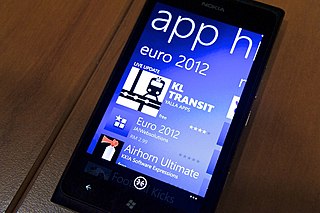
The Nokia Lumia 900 is a Windows Phone-powered smartphone, first unveiled on January 9, 2012, by Nokia at Consumer Electronics Show 2012, where it won the Best Smartphone award in January 2012. The phone has 4G LTE support and was released in April 2012. The Lumia 900 was the flagship smartphone of the Lumia range until the release of its successor, the Lumia 920.

The Nokia 808 PureView is a Symbian-powered smartphone first unveiled on 27 February 2012 at the Mobile World Congress. It is the first smartphone to feature Nokia's PureView Pro technology, a pixel oversampling technique that reduces an image taken at full resolution into a lower resolution picture, thus achieving higher definition and light sensitivity, and enables lossless digital zoom. It was one of the most advanced camera phones at the time of its release in May 2012.

Microsoft Lumia is a discontinued line of mobile devices that was originally designed and marketed by Nokia and later by Microsoft Mobile. Introduced in November 2011, the line was the result of a long-term partnership between Nokia and Microsoft—as such, Lumia smartphones run on Microsoft software, the Windows Phone operating system; and later the newer Windows 10 Mobile. The Lumia name is derived from the partitive plural form of the Finnish word lumi, meaning "snow".
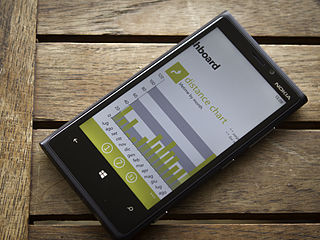
Nokia Lumia 920 is a smartphone developed by Nokia that runs the Windows Phone 8 operating system. It was announced on September 5, 2012, and was first released on November 2, 2012. It has a 1.5 GHz dual-core Qualcomm Krait CPU and a 4.5" IPS TFT LCD display, as well as a high-sensitivity capacitive touchscreen that can be used with gloves and fingernails; the display is covered by curved Gorilla Glass and has a 9 ms response time. The phone features an 8.7-megapixel PureView camera with OIS; it was the first smartphone camera to implement that technology, as well as to support Qi inductive charging. The phone comes with 32 GB of internal storage, but has no expandable storage.

Nokia PureView is the branding of a combination of technologies used in cameras of Nokia-branded smartphones, and previously, in phones by Microsoft Mobile. PureView was first introduced with Nokia 808 PureView.

The Nokia Lumia 520 is an entry-level Windows Phone 8 smartphone announced by Nokia at the 2013 Mobile World Congress.

Lumia imaging apps are imaging applications by Microsoft Mobile and formerly by Nokia for Lumia devices built on the technology of Scalado. The Lumia imaging applications were notably all branded with "Nokia" in front of their names, but after Microsoft acquired Nokia's devices and services business the Nokia branding was superseded with "Lumia", and often updates included nothing but name changes, but for the Lumia Camera this included a new wide range of feature additions. Most of the imaging applications are developed by the Microsoft Lund division. As part of the release of Windows 10 Mobile and the integration of Lumia imaging features into the Windows Camera and Microsoft Photos applications some of these applications stopped working in October 2015.

The Nokia Lumia 1020 is a smartphone developed by Nokia, first unveiled on 11 July 2013 at a Nokia event in New York. It runs Windows Phone 8, but is also Windows Phone 8.1 ready. It contains Nokia's PureView technology, a pixel oversampling technique that reduces an image taken at full resolution into a lower resolution picture, thus achieving higher definition and light sensitivity, and enables lossless digital zoom. It improves on its predecessor, the Nokia 808, by coupling a 41-megapixel 2/3-inch BSI sensor with optical image stabilization (OIS) and a high resolution f/2.2 all-aspherical 1-group Carl Zeiss lens. It was considered to be the most advanced cameraphone when released in September 2013.

The Nokia Lumia 625 is a Windows Phone with a 4.7-inch IPS LCD WVGA (480x800) screen and 4G support. It was presented on July 23, 2013. It can be loaded up with the latest software update for Windows Phone 8.1, as well as Nokia's firmware update 'Denim'. It borrows features from the Nokia Lumia 1520, the Lumia 1020 and the Lumia 925.

The Nokia Lumia 1520 was a flagship Windows Phone phablet smartphone designed and produced by Finnish telecommunications manufacturer Nokia in partnership with American software manufacturer Microsoft. The device was first announced at the Nokia World event on 22 October 2013 in Abu Dhabi, alongside its mid-range phablet stablemate the Nokia Lumia 1320 and Nokia's 10.1 inch Windows RT tablet the Nokia Lumia 2520. Until its discontinuation in the United States on 7 April 2015 the phone served as the flagship device for Nokia's Lumia Series and Microsoft's mobile effort. On 6 October 2015 Microsoft officially announced its flagship phablet successor, the Microsoft Lumia 950 XL, with availability sometime in November 2015.
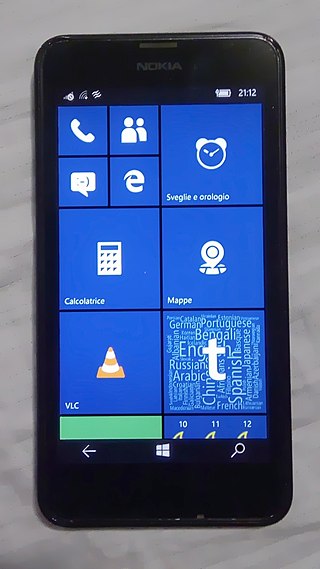
The Nokia Lumia 630 is a smartphone developed by Microsoft Mobile that runs Microsoft's Windows Phone 8.1 operating system. It was announced on 2 April 2014, at Microsoft Build 2014 and scheduled to be released in July 2014. It has a Qualcomm Snapdragon 400 SoC with a quad-core processor and Adreno 305 GPU. Additionally, it has a 4.5-inch display and a 5 MP camera. The Lumia 635 is similar but 4G-compatible, lacks a dual-SIM version and comes in a different finish, while the Lumia 636 and 638 are identical, but come with 1 GB of RAM and are currently available only in China and India respectively.

The Nokia X family was a range of budget smartphones that was produced and marketed by Microsoft Mobile, originally introduced in February 2014 by Nokia. The smartphones run on the Nokia X platform, a Linux-based operating system which was a fork of Android. Nokia X is also known generally as the Nokia Normandy. It is regarded as Nokia's first Android device during the company's Microsoft partnership and was in the process of selling its mobile phone business to Microsoft, which eventually happened two months later.

The Nokia Lumia 530 is an entry-level smartphone developed by Microsoft Mobile that runs the Windows Phone 8.1 operating system.
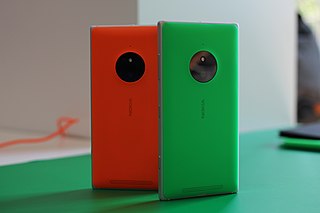
The Nokia Lumia 830 is a smartphone developed by Microsoft Mobile and branded as "Nokia" that runs Microsoft's Windows Phone 8.1 operating system. It was announced on September 4, 2014 at Internationale Funkausstellung Berlin and released in October 2014. It is a successor to the 2012 Nokia Lumia 820 and marketed as an "affordable flagship".

The Nokia Lumia 730 is a smartphone developed by Microsoft Mobile and branded as "Nokia" that initially runs Microsoft's Windows Phone 8.1 operating system. It was announced on September 4, 2014 at Internationale Funkausstellung Berlin and released in October 2014. It is a successor to the 2013 Nokia Lumia 720 and marketed as a selfie phone.
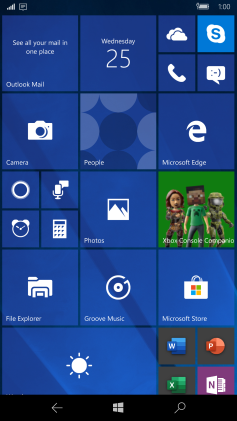
Windows 10 Mobile is a discontinued mobile operating system developed by Microsoft. First released in 2015, it is a successor to Windows Phone 8.1, but was marketed by Microsoft as being an edition of its PC operating system Windows 10.

Microsoft Lumia 950 is a smartphone developed by Microsoft, officially revealed on 6 October 2015 alongside the larger Lumia 950 XL. The phone was first released on AT&T in the United States on 17 November 2015, and subsequently made available on the Microsoft Store as well as in other countries.

The Microsoft Lumia 950 XL is a smartphone developed by Microsoft, officially revealed on October 6, 2015 and released on November 20, 2015 alongside the smaller Lumia 950. The Lumia 950 XL is the successor to the Nokia Lumia 1520 and is among the first phones to natively run Windows 10 Mobile. The phone is primarily aimed at users desiring a flagship device, in contrast to Microsoft's previous strategy of targeting developing markets with low-end hardware.


















